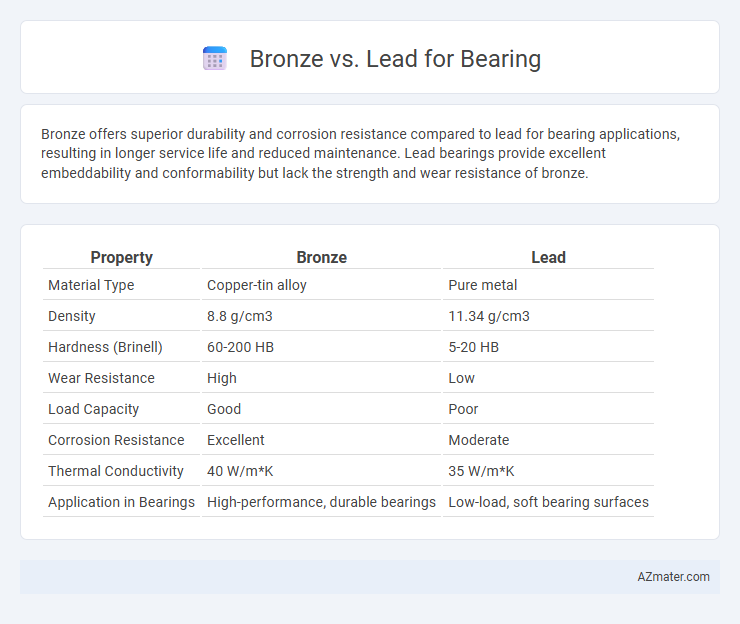Bronze offers superior durability and corrosion resistance compared to lead for bearing applications, resulting in longer service life and reduced maintenance. Lead bearings provide excellent embeddability and conformability but lack the strength and wear resistance of bronze.
Table of Comparison
| Property | Bronze | Lead |
|---|---|---|
| Material Type | Copper-tin alloy | Pure metal |
| Density | 8.8 g/cm3 | 11.34 g/cm3 |
| Hardness (Brinell) | 60-200 HB | 5-20 HB |
| Wear Resistance | High | Low |
| Load Capacity | Good | Poor |
| Corrosion Resistance | Excellent | Moderate |
| Thermal Conductivity | 40 W/m*K | 35 W/m*K |
| Application in Bearings | High-performance, durable bearings | Low-load, soft bearing surfaces |
Introduction: Bronze vs Lead in Bearing Applications
Bronze and lead are widely used materials in bearing applications due to their distinct mechanical properties and wear resistance. Bronze bearings offer high strength, excellent corrosion resistance, and durability under heavy loads, making them suitable for demanding industrial environments. Lead-based bearings provide superior lubrication and conformability, enhancing performance in low-speed or high-impact scenarios while minimizing friction and wear.
Material Composition and Properties
Bronze bearings typically consist of a copper-tin alloy with added elements like phosphorus, aluminum, or silicon to enhance strength, wear resistance, and corrosion resistance, making them suitable for high-load applications. Lead bearings, often made from leaded bronze or pure lead-based alloys, provide superior lubricity and embed small particles, reducing wear but generally have lower load capacity and strength compared to bronze. The high hardness and fatigue resistance of bronze alloys contrast with the exceptional conformability and low friction coefficients of lead-bearing materials, influencing their optimal use in various industrial scenarios.
Durability and Wear Resistance
Bronze bearings exhibit superior durability and wear resistance compared to lead due to their higher hardness and ability to withstand heavy loads without deformation. The microstructure of bronze allows for better lubrication retention, reducing friction and extending service life in industrial applications. Lead bearings, while softer and easier to machine, generally suffer from quicker wear and reduced lifespan under high-stress conditions.
Load-Bearing Capabilities
Bronze exhibits superior load-bearing capabilities compared to lead due to its higher tensile strength and better fatigue resistance, making it ideal for demanding bearing applications. Its ability to distribute heavy loads evenly reduces wear and extends bearing life under high-stress conditions. Lead, while softer and providing good conformability and embeddability, lacks the structural strength required for heavy or dynamic loads, limiting its use to lighter, low-load bearing environments.
Friction and Lubrication Performance
Bronze bearings exhibit lower friction coefficients compared to lead due to their superior wear resistance and ability to retain lubricants effectively, enhancing overall lubrication performance. The porous structure of bronze allows for efficient oil retention, reducing metal-to-metal contact and minimizing friction under varying load conditions. Lead bearings, while softer and easier to embed contaminants, generally suffer from higher friction and poorer lubrication retention, leading to increased wear and reduced operational efficiency.
Corrosion and Chemical Resistance
Bronze exhibits superior corrosion resistance compared to lead, especially in marine and acidic environments, making it ideal for bearings exposed to moisture or chemicals. Lead, while softer and offering excellent machinability, tends to oxidize and deteriorate faster when exposed to corrosive substances, reducing its longevity in harsh conditions. The presence of copper and tin in bronze alloys forms a protective oxide layer that enhances chemical resistance, extending the bearing's operational life.
Temperature Tolerance and Thermal Conductivity
Bronze bearings offer superior temperature tolerance, often withstanding continuous operating temperatures up to 450degF (232degC), making them suitable for high-heat environments. Lead bearings have lower temperature resistance, typically tolerating temperatures around 200-300degF (93-149degC), which limits their use in applications with elevated thermal demands. In terms of thermal conductivity, bronze exhibits better heat dissipation properties, enhancing bearing longevity by reducing overheating risks compared to the relatively poor thermal conductivity of lead alloys.
Cost-Effectiveness and Availability
Bronze bearings offer a balance of durability and moderate cost, making them a cost-effective choice for many industrial applications due to their widespread availability and long service life. Lead-based bearings, while generally cheaper upfront, tend to have shorter lifespans and may incur higher maintenance costs over time, impacting overall cost-effectiveness. The availability of bronze alloys is robust in the market, supporting large-scale production and replacement, whereas lead materials face tighter regulations and limited supply, affecting their practicality for long-term use.
Common Applications in Industry
Bronze bearings are widely used in automotive engines, heavy machinery, and electrical motors due to their excellent wear resistance, low friction, and ability to withstand high temperatures. Lead bearings, often found in applications such as pumps, compressors, and marine equipment, provide superior corrosion resistance and embedment properties, making them suitable for environments with heavy loads and contaminated lubricants. The selection between bronze and lead bearings typically depends on the operating conditions, load requirements, and exposure to harsh environmental factors in industrial settings.
Choosing the Right Bearing Material: Key Considerations
Bronze bearings offer superior wear resistance and load-carrying capacity compared to lead, making them ideal for high-stress applications requiring durability and longevity. Lead-based bearings provide excellent conformability and embedability, beneficial for reducing friction and accommodating contaminants in lower-load environments. Selecting the right bearing material depends on factors such as operating load, speed, temperature, and lubrication conditions, with bronze suited for heavy-duty uses and lead preferred for moderate loads with contamination concerns.

Infographic: Bronze vs Lead for Bearing
 azmater.com
azmater.com